
|
You entered: optical
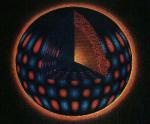 The Sun Oscillates
The Sun Oscillates
15.06.1999
Our Sun is in a continual state of oscillation. Large patches of the Sun vibrate in and out, back and forth, even as the Sun rotates. One mode of Solar oscillation is depicted graphically above, with blue indicating outward motion, and red indicating inward motion.
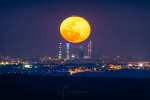 Four Towers and the Equinox Moon
Four Towers and the Equinox Moon
23.03.2019
The first Full Moon of northern spring rises behind four distant towers in this telescopic view. In an image captured from some 40 kilometers west of the city of Madrid, this moonrise also represents a near coincidence of the full lunar phase with lunar perigee and the March equinox.
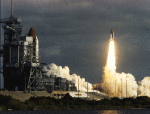 Columbia Waits, Discovery Launches
Columbia Waits, Discovery Launches
8.08.1995
Space Shuttle Discovery launches while the Space Shuttle Columbia is readied for a future mission. Space shuttles are launched from the Kennedy Space Center in Florida. At this date there are four operating space shuttles: Atlantis, Columbia, Discovery, and Endeavour. This mission is most famous for carrying the Hubble Space Telescope into orbit.
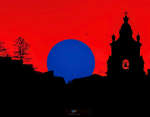 Sunset Afterimage
Sunset Afterimage
31.05.2025
On May 7, the Sun setting behind a church bell tower was captured in this filtered and manipulated digital skyscape from Ragusa, Sicily, planet Earth. In this version of the image the colors look bizarre.
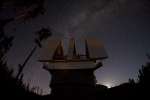 Large Binocular Telescope
Large Binocular Telescope
16.02.2008
With moonlight on the horizon, a starry sky and the northern Milky Way provide the background for this dramatic view of the World at Night. The imposing structure in the foreground houses the Large Binocular Telescope (LBT), on Mount Graham, Arizona.
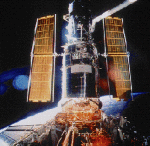 The Orbiting Hubble Space Telescope
The Orbiting Hubble Space Telescope
10.08.1995
The Hubble Space Telescope (HST) is the largest orbiting public optical telescope in history. Its 2.4 meter diameter reflecting mirror and its perch above Earth's atmosphere allow it to create exceptionally sharp images.
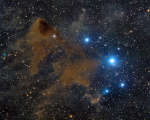 Lynds Dark Nebula 183
Lynds Dark Nebula 183
21.10.2017
Beverly Lynds Dark Nebula 183 lies a mere 325 light-years away, drifting high above the plane of our Milky Way Galaxy. Obscuring the starlight behind it when viewed at optical wavelengths, the dark, dusty molecular cloud itself seems starless.
 Saturn from Earth
Saturn from Earth
2.09.1998
Saturn is the second largest planet in our Solar System. Saturn has been easily visible in the sky since history has been recorded. Galileo used one of the first telescopes in 1610 to discover Saturn's rings, which he first thought were moons.
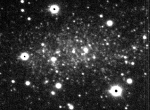 The Closest Galaxy: The Sagittarius Dwarf
The Closest Galaxy: The Sagittarius Dwarf
4.02.1996
What's the closest galaxy to our Milky Way? For many years astronomers thought it was the Large Magellanic Cloud (LMC). But the seemingly insignificant fuzzy patch shown above turned out to be part of a galaxy that is even closer.
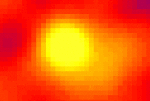 GRB970228: What's There?
GRB970228: What's There?
7.04.1997
Could this fuzzy blob be the key to the whole gamma-ray burst (GRB) mystery? Astronomers the world over are now scrambling to determine the true nature of the extended emission seen to the lower right of the bright source in the above image.
|
January February March April May June July |
|||||||||||||||||||||||||||||||||||||||||||||||||